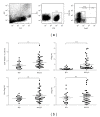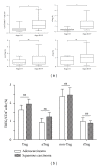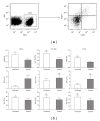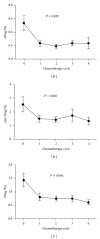Selective depletion of regulatory T cell subsets by docetaxel treatment in patients with nonsmall cell lung cancer
- PMID: 24868562
- PMCID: PMC4020463
- DOI: 10.1155/2014/286170
Selective depletion of regulatory T cell subsets by docetaxel treatment in patients with nonsmall cell lung cancer
Abstract
Regulatory T (Treg) cells are potent suppressors that maintain immune homeostasis. Accumulation of Treg can inhibit effective immune responses in cancer patients, leading to tumor development and progression. Despite direct cytotoxicity, several chemotherapeutic drugs have been reported to deplete Treg cells for better prognosis for cancer patients. Treg cells are a heterogenous population with at least three different subsets, nonsuppressive, resting, and activated Treg cells. However, the characteristics of Treg cell subsets in lung cancer patients and how chemotherapy affects Treg cells remain elusive. In this study, we first analyzed Treg cell subsets in peripheral blood samples from 40 nonsmall cell lung cancer (NSCLC) patients and 20 healthy donors. Treg cells, specifically activated Treg cell subset, significantly increased in patients with NSCLC. Compared to nonsuppressive Treg cells, activated Treg cells expressed higher level of CD39 and predominantly produced inhibitory cytokines. In vitro assay showed that docetaxel reduced all three subsets of Treg cells. More importantly, we found docetaxel-based chemotherapy significantly decreased all three Treg subsets after 4 cycles of treatment in 17 NSCLC patients. Taken together, this study revealed dynamic changes of various Treg cell subsets in NSCLC patients before and after chemotherapy, providing activated Treg cells as a potential target for chemotherapy.
Figures





References
-
- Zou W. Regulatory T cells, tumour immunity and immunotherapy. Nature Reviews Immunology. 2006;6(4):295–307. - PubMed
-
- Curiel TJ, Coukos G, Zou L, et al. Specific recruitment of regulatory T cells in ovarian carcinoma fosters immune privilege and predicts reduced survival. Nature Medicine. 2004;10(9):942–949. - PubMed
-
- Stoop JN, van der Molen RG, Baan CC, et al. Regulatory T cells contribute to the impaired immune response in patients with chronic hepatitis B virus infection. Hepatology. 2005;41(4):771–778. - PubMed
Publication types
MeSH terms
Substances
LinkOut - more resources
Full Text Sources
Other Literature Sources
Medical
Research Materials

